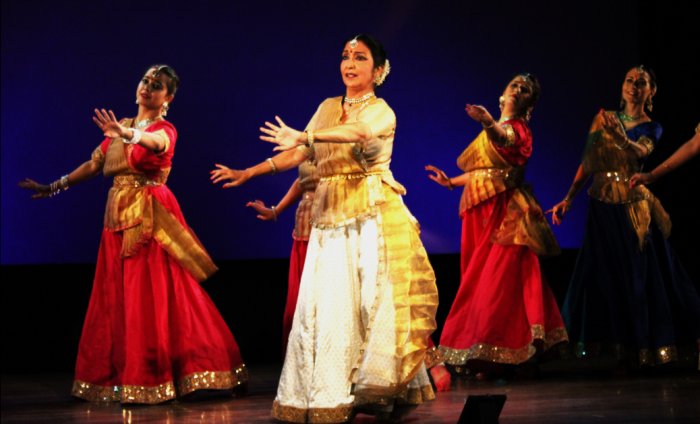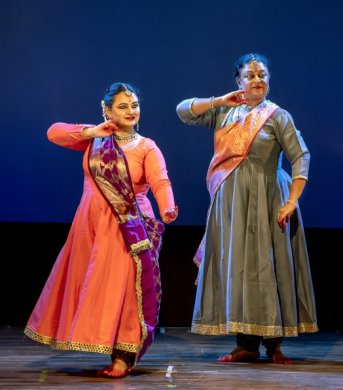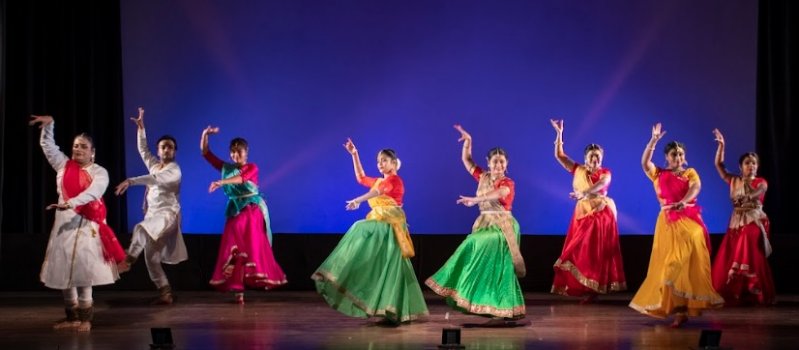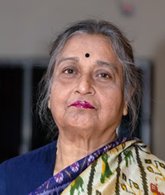
|   |

|   |
Brij Shyam-Shyam Chaabi: A tribute - Dr. Nita Vidyarthi e-mail: nitavidyarthi@gmail.com Photos courtesy: Anurekha Ghosh December 13, 2022 Great dancing had always been a gratification of the senses for its animated beauty and an art worthy of serious attention. Trained artistes, connoisseurs of art, ardent enthusiasts and the untrained eyes of the lay viewers show the high respect in which art and the giants in the field of dance have been held in all periods of civilised history. To those legendary dancers and Gurus of unquestioned authority in the field of Kathak was dedicated a long evening of 4 odd hours showcasing solos, duets and group presentations in distinctly sharpened compositions of technical brilliance and pure optical beauty of the tradition of the very prominent Kalka-Bindadin gharana, with deep respect and utmost reliability. The memorable evening titled 'Brij Shyam- Shyam Chaabi' was a humble tribute paid to the contemporary giant in the field of Kathak, Pandit Birju Maharaj, Guru Reba Vidyarthi, Guru Munna Shukla and Durga Arya's parents at the Satyajit Ray Auditorium, ICCR, Kolkata by Maharaj-ji's ace disciple Durga Arya (who was here all the way from Germany) in association with Anurekha Ghosh Dance Company, Kolkata. The idea was to retrieve, unfurl and showcase some of the gems of the prominent Lucknow gharana, as inherited from her legendary Guru Birju Maharaj, who had been holding fort till his last, together with a minute share of their treasure trove, graciously presented by the legend's daughter Mamta Maharaj, a distinguished dancer in her own right and the brilliant dancer-granddaughter Ragini. The austere decoration and stepwise arrangement of photographs of the masters (shared by the family of Pandit Birju Maharaj and Durga Arya) at one corner of the stage had a distinctly recognizable character of a personal warm touch of a family prayer room. The colours of the cloth on which the garlanded photographs were placed were symbolic (yellow for 'Brij Shyam') and instrumental in establishing a familial bond with the audience. Mamta Maharaj, Ragini, Durga Arya and well-known city-based Kathak dancer Anurekha Ghosh together with some renowned teachers from the city inaugurated the evening by joining in the Pushpanjali (offering of flowers).  Durga Arya & students The performances commenced with a well-rehearsed "Guru Vandana" by Durga Arya and her students supported by the projection of photographs of Kalka- Bindadin Maharaj and a video of Saswati Sen's earlier performance of the same on the screen behind. Durga Arya is an acclaimed dancer and knows her Guru's style inside out and completely absorbed herself in the movement and subtle nuances of the soul-stirring solo set to the popular "Kasturi tilakam lalatapataley", the 2.108 shlokam of Sri Krishna Karnamrutham by Bilva Mangala (AD1220-1300) that followed next. The audience saw a highly involved dancer who had internalised the essence of the beautiful lyrics so essential for a successful abhinaya. The popular Shiv Vandana "Niratata Shankara Parvati Sanga" by Anurekha Ghosh and female dancers with one male, saw unerring grip on rhythm and vocabulary in the nritta based item with decorative technical flashes. Beginning with stances of Nataraj, the dancers concluded the vivacious rhythm based number with a fine tatkar and finally a Shankar-Parvati freeze. It was also a small tribute for Debashish Sarkar, the excellent accompanying vocalist whom the dance world lost during the pandemic.  Anurekha Ghosh & group Embellished with chakkars, "Teen Taal" by Anurekha Ghosh and the group was a fine viewing experience of intricate rhythms, nritta and footwork negotiated by the group with Anurekha standing out for her energetic exploration and execution of rhythmic layers of the paranth. Some of the commendable group numbers led by Durga Arya to luxuriate upon were the bhajan "Awat Shyam lachakachale mukuta dhare" on the stage and simultaneously with slides on the screen by Birju Maharaj (courtesy Doordarshan), "Varanata chabi Shyam sundara eiso mohakara chaal", where Maharaj-ji's hypnotic voice and mellifluous singing overpowered the otherwise well-coordinated graceful dancing. Embellished with elegant sways, the Thumri "Bharanata jaawat panghat ki gagariya" by Durga Arya portraying Radha going to fill water with other maidens displayed proficiently the bhavpaksh with nazakat and khubsurti of the Lucknow gharana. The ghazal "Teri mehfil mein" embellished with sargams by Durga Arya and two female dancers was another example where the delicate emotions of love touched the heart strings.  Ragini & Mamta Maharaj The crowning glory of the evening was the duets and solos by Mamta Maharaj and Ragini where the audience had the privilege of watching some "dekhi aur ansuni baatey" (never seen or heard before), some family treasures or "Parivar Parampara" of the Kalka-Bindadin Gharana. They began with the signature invocation "Namami Krishna Sundaram" followed by the pure dance elements of Kathak in "Raja Taal" (teen taal) - sarod e naghma, scintillating layakari, Upaj, Thaat, riveting Uthan, Paran and Tihai and bandishes, some of which Ragini, while having the advantage of staying with her grandfather, capitalized in the lockdown and learnt few of the "Parivar ki cheezey" - novelties of bols and gems of the family. Ragini began with Gat Nikas or Gati, inspired by things of everyday life. First "Hathi ki chaal" (gait of an elephant), then a hilarious imagery of "Patang katney ka" (flying and dislodging a kite), "Fukarey" (calling friends) based heavily on "ginti" and other intra forms and was at home with the audience. She graciously attended to requests like Maharaj-ji's favourite "Aanchal ki gat" and brought it out beautifully. Two duets, the Shiv ke paran "Jata shobhit chandra chamakata jai Shiva" and the delightful Mishra Kafi based Holi Thumri "Tum to karata barjori" of aunt and niece - Mamta Maharaj and Ragini - recounted intensely mature understanding. The visualisation, the mood, the execution, the dancers' expertise of the form and the abhivyakti with the richness of the alankaras blended seamlessly with the lyrical beauty of the song offering intellectual delight in totality to the number. The energetic nritta segment by Mamta Maharaj gave a taste of rare gems of compositions in vilambit and Dhamar Taal. Her powerful and robust dancing and fantastic negotiation of Tihai landing pat at the sam was a joy to watch. She presented a bol of Jaikishan Maharaj's composition where one starts at dha dhin ta and ends in dha dhin ta. The vocal support of the performances of the aunt-niece duo was by Debapriya Dasgupta with Sudip Thakur on the tabla. The concluding segment "Baaji ri bansi" was effectively a bouquet of lovely group numbers by Durga Arya and her disciples of choicest compositions of Pandit Birju Maharaj starting with the title song followed by a compelling nritta segment of taal Dhamar. Two memorable numbers that touched the chords were "Subhayee rijhayee manbhayee" and the evergreen "Eri sakhi kaase kahu mein Kanha kinnhi chaturayee", again the mellifluous singing ruling the presentation scene. The last number was particularly touching as it reminds one of the Padatik days when Maharaj-ji used to be here to rehearse and present his spectacular mega production Shristi, on Fort Radison in Raichak in 1999.  The series of dances one after the other did not allow any monotony to creep in for good dancing of the hand-picked exotic numbers set to the marvellous singing of Pandit Birju Maharaj. Interest was generated by the projection of the mighty work in rare clippings of performances, practice sessions, teaching and informal baitaks of the stalwarts, generation after generation, on the large screen placed behind the stage. It was truly a rare opportunity to have a glimpse of old photographs of masters who have enriched the gharana and some light joyous moments like Pandit Birju Maharaj practising tatkaar, clad only in short pyjamas at home! Naturally the audience in the overcapacity auditorium was ready for a glorious journey to the past and an exciting performance in the present. Durga Arya and Anurekha Ghosh's efforts are praiseworthy for offering such a worthwhile tribute to the great maestros and receive charming audience response.  Dr. Nita Vidyarthi is a veteran critic of performing arts and writes on dance, music and theatre in leading publications. |